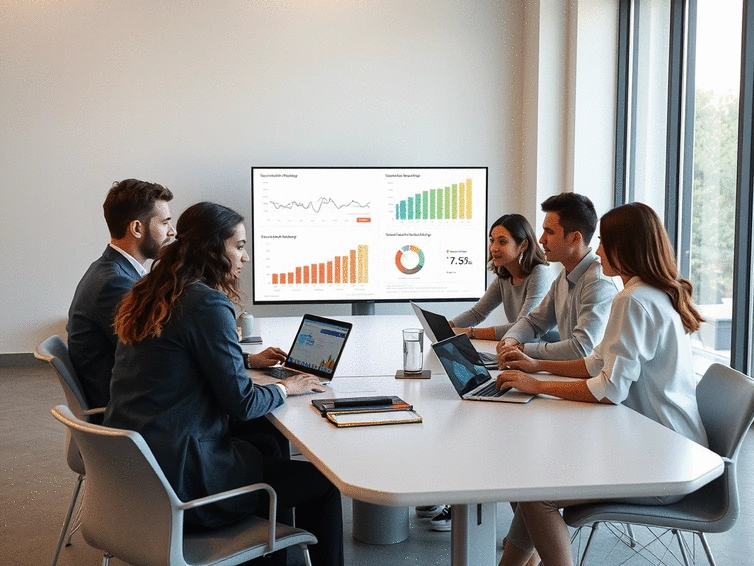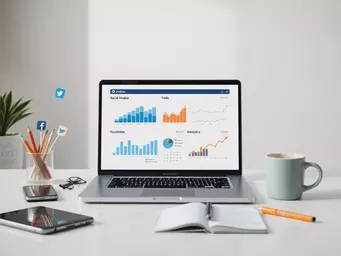
Building a Scalable Influencer Strategy
In a world where online interactions shape brand identities, understanding the nuances of influencer marketing is paramount. As we step into 2025, this landscape is not just changing; it’s evolving rapidly, presenting both challenges and opportunities for brands willing to adapt. Are you ready to navigate the exciting world of influencer strategies?
What You Will Learn
- The shift towards micro-influencers offers brands access to niche markets with authentic connections.
- Prioritizing authenticity and relatability over polished content enhances audience engagement.
- Video content, especially on platforms like TikTok, is crucial for effective storytelling and audience resonance.
- Scalable influencer marketing strategies focus on measurable performance and adaptable campaigns.
- Understanding platform-specific dynamics is essential for customizing influencer strategies and maximizing reach.
- Continuous learning and adaptation keep brands relevant in the fast-paced digital landscape.
- Engaging with influencers through clear communication fosters positive collaborations and campaign success.
- A well-planned content schedule and diverse content types enhance audience interaction and retention.
Key Strategies for Influencer Growth & Platform Roles in 2025
The visual below outlines the critical components for a scalable influencer strategy and highlights how different social media platforms shape influencer approaches.
Critical Components for Scalable Influencer Strategy
- ✓ Realistic budgets & long-term goals
- ✓ Clear campaign objectives
- ✓ Leveraging different influencer tiers
- ✓ Integrating user-generated content
- ✓ Utilizing technology to streamline
Social Media Platforms & Their Impact on Strategy
Instagram:
Focus on aesthetics, stories, and IGTV for longer content.
TikTok:
Emphasis on trends, challenges, and user-generated content.
Facebook:
Relevant for community building and targeted ads.
Twitter:
Great for real-time engagement and updates.
Understanding the Landscape of Influencer Marketing in 2025
As we dive into 2025, the influencer marketing landscape is rapidly evolving. The dynamics of social media, consumer behavior, and digital culture all play pivotal roles in shaping the strategies brands must adopt to stay relevant. It's fascinating to see how influencer marketing continues to morph, providing new opportunities for engagement and connection. But what are the current trends driving these strategies?
In my experience at Likers Network, I've observed a significant shift towards authenticity and relatability. Brands are increasingly looking for influencers who resonate genuinely with their audiences. This is a vital factor to consider as we explore further.

Current Trends Impacting Influencer Strategies
- Increased focus on micro-influencers for niche markets
- Authenticity over polish: real stories over staged content
- Video content taking precedence, especially on platforms like TikTok
- Data-driven campaigns leveraging analytics for performance
These trends highlight the importance of adapting to a more discerning audience. Consumers are gravitating towards influencers who not only share their values but also engage in meaningful conversations. As a brand, it’s crucial to identify influencers who can authentically convey your message.
Moreover, the rise of short-form video content is undeniable. Platforms like TikTok are leading the charge, making it essential for brands to pivot their strategies accordingly. Engaging content is not just about flashy visuals anymore; it’s about storytelling that resonates.
Why Scalability Matters in Influencer Marketing
Scalability is a key consideration when developing your influencer marketing strategy. As a brand, you want to maximize your reach and impact without sacrificing quality. This means creating a framework that allows for growth while maintaining the essence of your brand identity.
- Establishing clear metrics to measure influencer performance
- Creating adaptable campaign structures that can be scaled
- Investing in technology that facilitates expanded reach and engagement
To me, scalability is about building a sustainable model. It's not just about hitting numbers; it's about nurturing relationships that can evolve over time. By focusing on scalable strategies, brands can ensure they’re not just riding the wave of trends, but also setting the stage for long-term success.
The Role of Social Media Platforms in Influencer Marketing
Social media platforms are the lifeblood of influencer marketing. They dictate how content is shared, consumed, and engaged with. As we move further into 2025, understanding the nuances of these platforms is crucial for any brand looking to thrive.
How Platforms Like Instagram and TikTok Shape Influencer Strategies
Take Instagram and TikTok, for instance. Each platform has its unique audience and style, which influences how influencers create content. On Instagram, we often see polished visuals and curated feeds, while TikTok thrives on spontaneity and creativity.
- Instagram: Focus on aesthetics, stories, and IGTV for longer content.
- TikTok: Emphasis on trends, challenges, and user-generated content.
- Facebook: Still relevant for community building and targeted ads.
- Twitter: Great for real-time engagement and updates.
By understanding the strengths and weaknesses of each platform, brands can tailor their influencer strategies to maximize reach and engagement. Every platform offers unique opportunities to connect with audiences, so don’t overlook any potential avenues!
Engage with Us!
As we explore the dynamic world of influencer marketing, we want to hear your thoughts! What challenges have you faced in adapting your strategies to the latest trends? Share your experiences with us below:
Frequently Asked Questions About Influencer Marketing in 2025
- What is the main shift in influencer marketing for 2025?
- The primary shift is towards authenticity and relatability, with a growing focus on micro-influencers and video content, especially on platforms like TikTok.
- Why are micro-influencers becoming more important?
- Micro-influencers are crucial because they offer access to niche markets with highly engaged and authentic connections, which can lead to better campaign performance.
- How does video content impact influencer strategies?
- Video content, particularly on TikTok, is taking precedence for effective storytelling and audience resonance. Brands need to prioritize engaging and authentic video content.
- What does "scalability" mean in influencer marketing?
- Scalability refers to creating a sustainable framework that allows for growth and expanded reach while maintaining brand identity and nurturing long-term relationships with influencers.
- How do different social media platforms influence strategy?
- Each platform has unique characteristics; for example, Instagram focuses on aesthetics, while TikTok emphasizes trends and user-generated content. Brands must tailor their strategies to leverage the strengths of each platform for maximum reach and engagement.
- Why is continuous learning important in influencer marketing?
- Continuous learning and adaptation are essential to stay relevant in the fast-paced digital landscape, as trends shift and new platforms emerge. This includes analyzing data, staying informed, and refining approaches.
- What are some critical components for a scalable influencer strategy?
- Key components include realistic budgets, clear campaign objectives, leveraging different influencer tiers, integrating user-generated content, and utilizing technology to streamline processes.
- How can brands ensure successful collaboration with influencers?
- Successful collaboration involves establishing clear communication, providing comprehensive briefs, encouraging creative freedom, and regularly checking in throughout the campaign.
Summary of Key Strategies for Influencer Growth in 2025
As we navigate the evolving world of influencer marketing, it's crucial to keep a close eye on the strategies that will drive growth in 2025. Here’s a quick recap of the critical components needed for a scalable influencer strategy:
- Establishing realistic budgets that align with your long-term goals.
- Defining clear campaign objectives that resonate with your audience.
- Leveraging different tiers of influencers to maximize your ROI.
- Integrating user-generated content to foster authentic connections.
- Utilizing technology to streamline processes and enhance relationships.
By focusing on these elements, you can build a robust framework for your influencer marketing efforts, ensuring that your strategies are both effective and sustainable.
The Importance of Continuous Learning and Adaptation in Influencer Marketing
In the fast-paced digital landscape, staying ahead means embracing a mindset of continuous learning. As trends shift and new platforms emerge, the ability to adapt is essential. This includes:
- Regularly analyzing campaign performance data to identify areas for improvement.
- Staying informed about the latest social media developments and consumer behavior.
- Participating in industry webinars, workshops, and networking events.
- Soliciting feedback from your influencer partners to refine your approach.
At Likers Network, we emphasize the importance of remaining agile. By continuously learning and adapting, you’ll be better equipped to meet the evolving demands of your audience and the industry. Understanding the effectiveness of influencer campaigns and the psychological aspects of consumer engagement, as highlighted by various studies, further underscores this point.

Next Steps: Building Your Influencer Growth Framework
Utilizing Resources and Tools for Implementation
Once you’ve defined your strategy, it’s time to put it into action! Utilizing the right resources and tools is key to implementing your influencer growth framework effectively. Consider the following:
- Influencer marketing platforms that provide analytics and outreach capabilities.
- Content scheduling tools to streamline your posting process.
- Budget management software to keep your campaigns financially on track.
- Community engagement tools to enhance interaction with your audience.
Leveraging these resources will not only save you time but also help you maintain a cohesive strategy as you engage with influencers in your niche.
Engaging with Influencers for Successful Campaign Launches
Engagement is vital when launching successful influencer campaigns. Here are some strategies I recommend to ensure smooth collaboration with your influencers:
- Establish clear communication channels from the start.
- Provide comprehensive briefs that outline campaign goals and expectations.
- Encourage creative freedom, allowing influencers to share their unique perspectives.
- Regularly check in throughout the campaign to maintain alignment.
By fostering open communication and collaboration, you’ll create a more positive experience for both your brand and the influencers you work with. This approach aligns with research on social media marketing's influence on consumer behavior, emphasizing the importance of genuine interaction.
The Impact of Content Scheduling and Diversification on Campaign Success
Finally, let’s talk about content scheduling and diversification. An effective content schedule is foundational to any influencer campaign. Here’s why:
- Consistent posting helps maintain audience interest and engagement.
- Diversifying content types (videos, stories, posts) caters to different audience preferences.
- Scheduling allows for timely promotions that align with seasonal trends or events.
At Likers Network, we believe in the power of strategic content planning. By diversifying your content and adhering to a well-thought-out schedule, you can maximize the impact of your campaigns and foster a deeper connection with your audience.
Recap of Key Points
Here is a quick recap of the important points discussed in the article:
- Focus on authenticity and relatability when selecting influencers.
- Leverage micro-influencers for targeted niche markets.
- Prioritize video content, especially on platforms like TikTok.
- Utilize data-driven campaigns to measure performance effectively.
- Establish clear metrics and adaptable structures for scalable influencer strategies.
- Engage with different social media platforms to tailor your approach.
- Continuously learn and adapt to stay ahead in influencer marketing.
- Use the right tools and resources for effective campaign implementation.





Gaming Communities and Digital Culture
Social Media Growth Tactics
Social Media Trends to Watch
Grow Your Audience with Hashtags
Smart Glasses and Urban Living